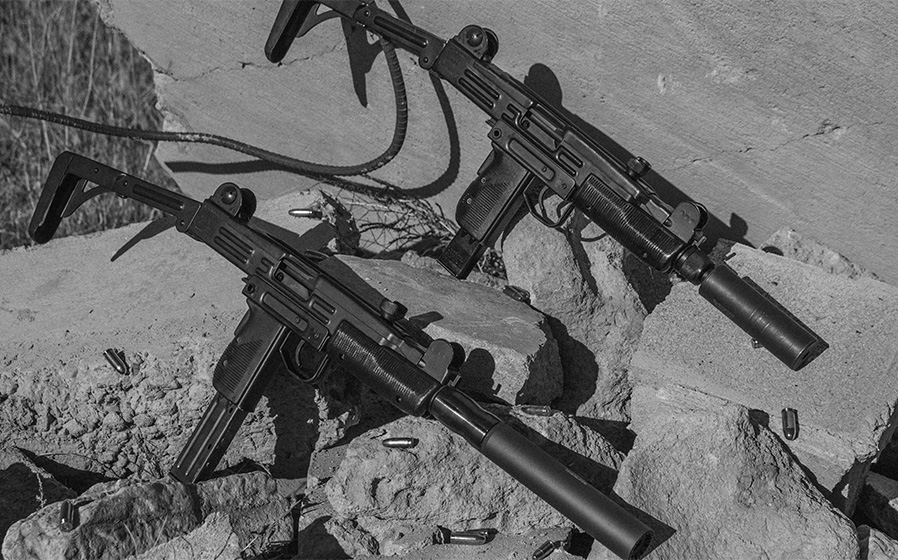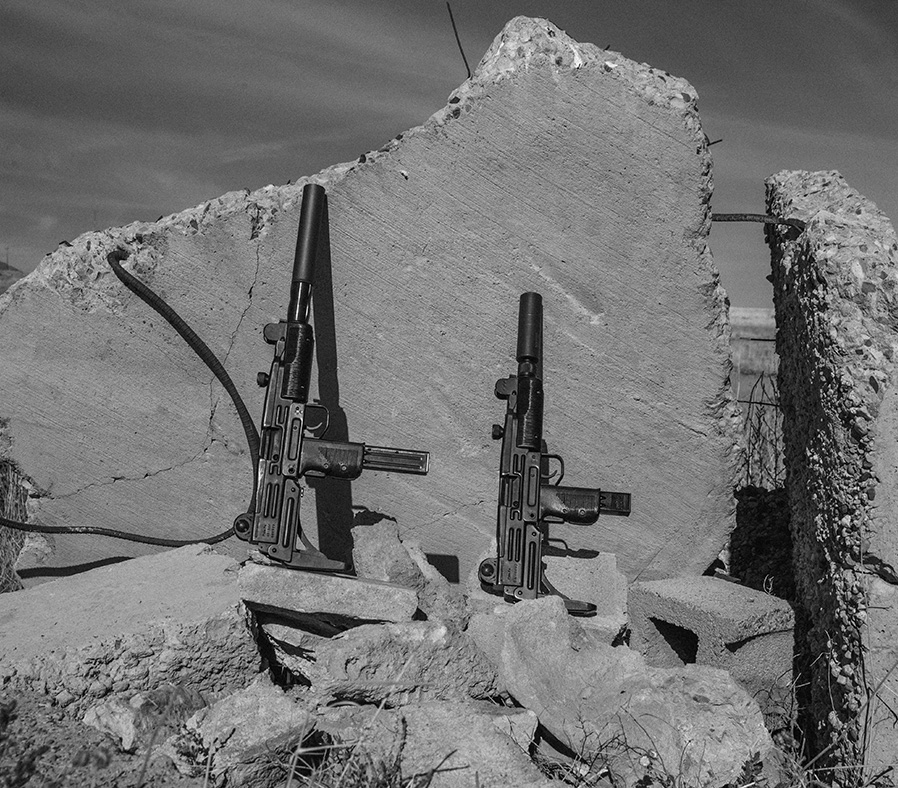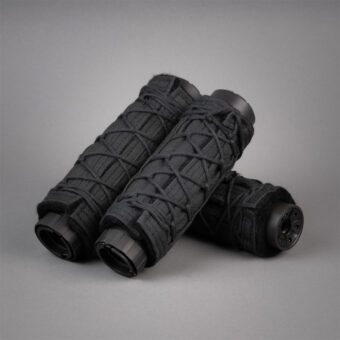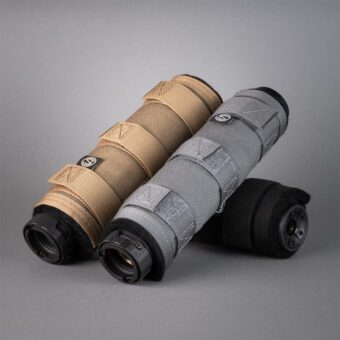Home / Silencer & Gun News / Arsenal Blog 002: Uzi
Arsenal Blog 002: Uzi
Home / Silencer & Gun News / Arsenal Blog 002: Uzi
Arsenal Blog 002: Uzi
ILENCERCO’S ARSENAL SERIES showcases guns we love for various reasons that reside in our in-house Arsenal. While we are best-known for making guns quiet, in order to do so we interact with a great variety of amazing platforms. In these posts we will tell you about each platform we like, why it’s different and relevant, and why we think it belongs in our pantheon of greatness.
The Uzi was developed by Uziel Gal (1924-2002), an Israeli army captain and won an internal competition for the design of a new sub machine gun that was supposed to be simple, durable, and fire from an open bolt. The first prototypes appeared in 1950 and soon after the first production batches were issued to selected Israeli units for field testing. An improved design appeared just before the Sinai Campaign of 1956 and it was in this desert war that the Uzi emerged as a winner in the highly demanding surroundings because loose tolerances and extreme durability enabled it to work reliably no matter what with little maintenance.
The Uzi was used as a personal defense weapon by rear-echelon troops, officers, artillery troops and tankers, as well as a frontline weapon by elite light infantry assault forces. The Uzi’s compact size and firepower proved instrumental in clearing Syrian bunkers and Jordanian defensive positions during the 1967 Six-Day War. Though the weapon was phased out of frontline IDF service in the 1980s, some Uzis and Uzi variants were still used by a few IDF units until December 2003, when the IDF announced that it was retiring the Uzi from all IDF forces. It was subsequently replaced by the fully automatic Micro Tavor.
The Uzi proved especially useful for mechanized infantry needing a compact weapon, and for infantry units clearing bunkers and other confined spaces. However, its limited range and accuracy in automatic fire (approximately 50 yards) was a disadvantage when encountering enemy forces armed with longer-range small arms, and heavier support weapons could not always substitute for a longer-ranged individual weapon. These failings eventually caused the phasing out of the Uzi from IDF front-line assault units. The Uzi family had a second life outside of military use as a personal defense weapon for private security, federal agencies, and law enforcement because of its concealability and reliability.

Why is The Uzi Interesting To Us?
1. The Uzi was one of the first weapons to use a telescoping bolt design which allows the magazine to be housed in the pistol grip to enable a shorter overall weapon. Some of the precursors to the Uzi which used telescoping bolt designs include the Japanese Type 1 sub-machinegun from 1935
2. The Uzi had three variants so the operator could accept tradeoffs and get the smallest package he needed for the job at hand The Uzi, the Mini-Uzi and the Micro-Uzi. These are all blowback, open bolt variants designed in the last century.
The Uzi is the original member of the family. This standard Uzi has a 10-inch barrel. When chambered in 9mm, it has a rate of automatic fire of 600 rounds per minute. The .45 ACP models fire at a rate of 500 rpm.
The Uzi is almost 26 long with the stock extended and 18.5 long with the stock folded. The Uzi’s angular body is made from pressed steel components. Empty cases are ejected through slots in the body. It weighs in at almost 8 lbs.
The Mini-Uzi is a smaller version of the Uzi. It was introduced in the 1980’s with the aim of providing a smaller and easy to operate variant. Its barrel length is more than 2 shorter than the Uzi and has a greater automatic rate of fire of 950 rounds per minute due to the shorter bolt.
The dimensions were reduced while an improved folding stock and sights were added to the design. The result was an exceptionally balanced package and an instant hit straight upon launch. The MiniiUzi is almost 24 long with the stock extended and a little 14 long with the stock folded. Its weight is almost 6 lbs.
The Micro-Uzi is an even further scaled down version of the Uzi, introduced in 1986. The Micro-Uzi has a barrel length that is almost half the Mini at 4.6 inches and it was designed to be essentially a fully automatic handgun. It was also created to assume the role of Personal Defense Weapon (PDW) in various combat units.
The Micro-Uzi is 19 inches long with the stock extended, and 11 inches long with the stock folded. Its cyclic rate of fire is 1,200 rpm. it weighs a bit over 3 pounds.
The original magazines for the 9mm Uzi were 25-round. Experimental 40- and 50-round extended magazines were tried but were found to be unreliable. A 32-round extended magazine was then tried and was later accepted as standard. The Mini Uzi and Micro-Uzi use a shorter 20-round magazine.
3. All Uzi variants are suppressable. Here we show a .45 ACP Uzi with a Octane 45K and an 9mm Mini- UZI with an Omega 9K with the stocks extended. The best thing about compact and small is you can add a silencer!
The Uzi has been exported to over 90 countries. Over its service lifetime, it has been manufactured by Israel Military Industries, FN Herstal, and other manufacturers. From the 1960s through the 1980s, more Uzi submachine guns were sold to more military, law enforcement and security markets than any other submachine gun ever made.

Other Things We Like:
SThe magazine release button or lever is located on the lower portion of the pistol grip and is intended to be manipulated by the non-firing hand. The paddle-like button lies flush with the pistol grip in order to help prevent accidental release of the magazine during rigorous or careless handling.
Uzis of all variants came in multiple calibers including 9x19mm, .22 LR, .45 ACP, .41 AE. There are caliber conversion kits in existence. The operator just has to change the barrel, bolt and magazine.
The immediate action drill to clear a malfunction in the original manual includes slamming the magazine on the ground or another solid surface to dislodge. To get the stock to extend it takes a not insignificant amount of force, Everything about the Uzi screams durability it would even serve well in hand to hand combat as a bludgeoning instrument.
The bolt design exposes the breech end of the barrel and improves cooling during periods of continuous fire
All variants were primarily built from stamped sheet metal, making it less expensive per unit to manufacture than an equivalent design machined from forgings.
With relatively few moving parts, the Uzi is easy to strip for maintenance or repair.
The magazine is housed within the pistol grip, allowing for intuitive and easy reloading in dark or difficult conditions.
The pistol grip is fitted with a grip safety, making it difficult to fire accidentally and there is an additional safety as part of the selector lever
When the gun is de-cocked the ejector port closes, preventing entry of dust and dirt. Though the Uzi’s stamped-metal receiver is equipped with pressed reinforcement slots to accept accumulated dirt and sand, the weapon can still jam with heavy accumulations of sand in desert combat conditions when not cleaned regularly. The magazine must be removed prior to de-cocking the weapon.
The Uzi features a bayonet lug.
You can shoot two at once, enough said.
Things We Don’t Like
The protruding vertical magazine makes the gun awkward to fire when prone.
The trigger mechanism is a conventional firearm trigger, but functions only to control the release mechanism for either the bolt (submachine gun) or firing pin holding mechanism (semi-auto) since the Uzi does not incorporate an internal cocking or hammer mechanism. While the open-bolt system is mechanically simpler than a closed-bolt design (e.g. Heckler & Koch MP5), it creates a noticeable delay between when the trigger is pulled and when the gun fires.
The smaller the gun the faster it fires the Micro Uzi can fire through a 20 rd magazine in less than 2 seconds flat which makes it hard to engage anything accurately even with the best of intentions.








